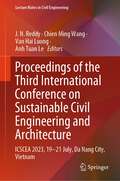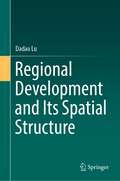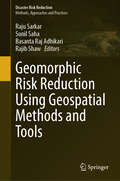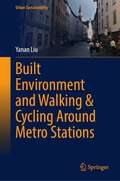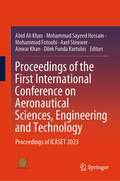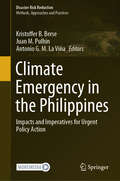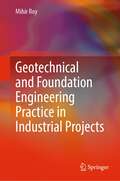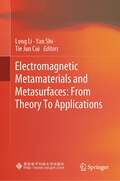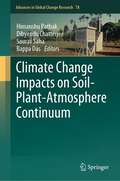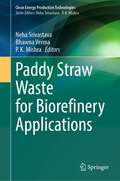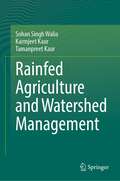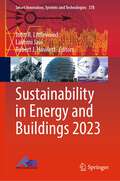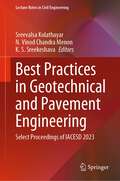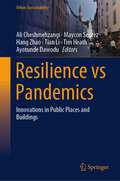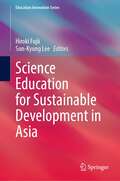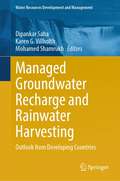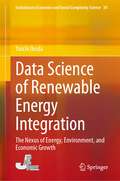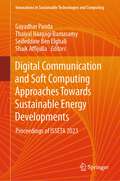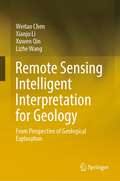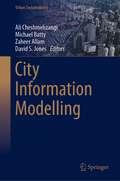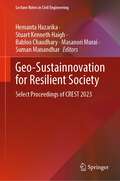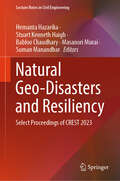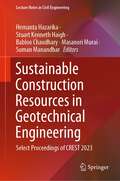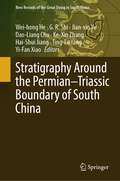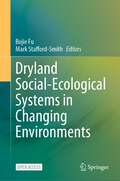- Table View
- List View
Proceedings of the Third International Conference on Sustainable Civil Engineering and Architecture: ICSCEA 2023, 19–21 July, Da Nang City, Vietnam (Lecture Notes in Civil Engineering #442)
by J. N. Reddy Chien Ming Wang Van Hai Luong Anh Tuan LeThis book includes articles from the Third International Conference on Sustainable Civil Engineering and Architecture (ICSSEA 2023), held at Da Nang City, Vietnam, on July 19-21, 2023. The conference brings together international experts from both academia and industry to share their knowledge and expertise, facilitate collaboration, and improve cooperation in the field. The book focuses on the most recent developments in sustainable architecture and civil engineering, including offshore structures, structural engineering, building materials, and architecture.
Regional Development and Its Spatial Structure
by Dadao LuThis book describes the progress and prominent theories of regional development research in the past decades, especially in the past decade, discusses the industrial structure, spatial structure, resources, and environment, as well as a series of practical issues, and reveals the general characteristics of spatial structure evolution in the process of regional development. The research on the issues of regional development has become the frontier of relevant disciplines since the 1950s, and much progress has been made in the process of solving practical problems in social and economic development. This book provides an in-depth and systematic demonstration of the "point-axis system" theory of regional exploitation and development as well as the T-shaped structure of China's regional economic action in theory and practice and discusses the impact of location differential rent, restricted accessibility, technological innovation, etc., on regional development theoretically. This book is used as a reference for planning, scientific research, and teaching personnel in territorial expansion, regional economy, human geography, etc.
Geomorphic Risk Reduction Using Geospatial Methods and Tools (Disaster Risk Reduction)
by Raju Sarkar Sunil Saha Basanta Raj Adhikari Rajib ShawThis book explores the use of advanced geospatial techniques in geomorphic hazards modelling and risk reduction. It also compares the accuracy of traditional statistical methods and advanced machine learning methods and addresses the different ways to reduce the impact of geomorphic hazards.In recent years with the development of human infrastructures, geomorphic hazards are gradually increasing, which include landslides, flood and soil erosion, among others. They cause huge loss of human property and lives. Especially in mountainous, coastal, arid and semi-arid regions, these natural hazards are the main barriers for economic development. Furthermore, human pressure and specific human actions such as deforestation, inappropriate land use and farming have increased the danger of natural disasters and degraded the natural environment, making it more difficult for environmental planners and policymakers to develop appropriate long-term sustainability plans. The most challenging task is to develop a sophisticated approach for continuous inspection and resolution of environmental problems for researchers and scientists. However, in the past several decades, geospatial technology has undergone dramatic advances, opening up new opportunities for handling environmental challenges in a more comprehensive manner.With the help of geographic information system (GIS) tools, high and moderate resolution remote sensing information, such as visible imaging, synthetic aperture radar, global navigation satellite systems, light detection and ranging, Quickbird, Worldview 3, LiDAR, SPOT 5, Google Earth Engine and others deliver state-of-the-art investigations in the identification of multiple natural hazards. For a thorough examination, advanced computer approaches focusing on cutting-edge data processing, machine learning and deep learning may be employed. To detect and manage various geomorphic hazards and their impact, several models with a specific emphasis on natural resources and the environment may be created.
Built Environment and Walking & Cycling Around Metro Stations (Urban Sustainability)
by Yanan LiuThis book explores the relationship between pedestrians/cyclists’ mode and route choice to/from metro/railway stations and the micro-level (street-scale) built environment in a second-tier city in China. More specifically, it investigates how the street-scale built environment influences pedestrians/cyclists’ mode choice and route choice behavior and examines user preferences for the micro-level built environment around metro stations. The focus on a second-tier city is motivated primarily to expand the set of Chinese cities where the effects of the built environment on pedestrian/cyclist mode and route choice have been studied. Results demonstrate the effects of the street-scale built environment on pedestrian flows. The effects are higher for the main road, which is directly connected with the metro station. The findings of this book are expected to support the design of preferred walking/biking built environments around a metro station. This book appeals to urbanists, planners, engineers, policy makers, and those interested in a wide-ranging overview of slow/green transportation and built environment promotion. These methods not only help to understand the quantitative relationship between built environment design and travel behavior but also support the evaluation and assessment of built environment design in urban planning projects. It reduces the gap in our understanding of the quantitative relationship between the micro-level built environment and pedestrians/cyclists’ transportation mode and route choice around the metro station. Both stated choice data and revealed choice data were used. An extended set of micro-level built environment attributes was developed. Besides the widely studied transportation-related factors, street-level built environment factors were studied using quantitative methods.
Proceedings of the First International Conference on Aeronautical Sciences, Engineering and Technology: Proceedings of ICASET 2023
by Abid Ali Khan Mohammad Sayeed Hossain Mohammad Fotouhi Axel Steuwer Anwar Khan Dilek Funda KurtulusThis volume contains forty-one revised and extended research articles, written by prominent researchers participating in the International Conference on Aeronautical Sciences, Engineering and Technology 2023, held in Muscat, October 3-5 2023. It focuses on the latest research developments in aeronautical applications, avionics systems, advanced aerodynamics, atmospheric chemistry, emerging technologies, safety management, unmanned aerial vehicles, and industrial applications. This book offers the state of the art of notable advances in engineering technologies and aviation applications and serves as an excellent source of reference for researchers and graduate students.
Climate Emergency in the Philippines: Impacts and Imperatives for Urgent Policy Action (Disaster Risk Reduction)
by Kristoffer B. Berse Juan M. Pulhin Antonio G. M. La ViñaThis book provides a snapshot of the manifestations of the climate emergency in the Philippines from a wide array of disciplines including physical sciences, social sciences, arts and humanities, management, and law. Researchers and faculties at the University of the Philippines contributed to this compilation, where each chapter provides policymakers and the public a clear picture of why climate change must be confronted with a sense of urgency and near-desperation.Divided into three main parts, the first one zeroes in on climate-vulnerable sectors such as water, food and agriculture, health, and coastal communities in the Philippines to introduce readers to the current pressing impacts of the climate emergency. The second part presents case studies of local experiences from the country’s three island regions, namely, Luzon, Visayas, and Mindanao, and it situates the readers in different environments and contexts. The third part features transdisciplinary responses to the climate emergency, including salient challenges in relation to planning, financing, communication, and education. The concluding chapter highlights eight areas for action to tackle the climate emergency. Each chapter comes with an overview and a Summary for Policymakers, which provides clear guidance for action to be taken by both local and national policymakers.
Geotechnical and Foundation Engineering Practice in Industrial Projects
by Mihir RoyThis professional book is an important resource on the topics of geotechnical and foundation engineering for practicing engineers and consultants. It fills the gap between classroom education and real-world professional practice in green and brown field projects. It provides hands-on knowledge on various topics such as engineering geology, geotechnical investigation, site preparation, ground improvement, foundation on soft and filled-up soil, pile foundation, seepage control, erosion control and retaining wall, marine projects, simplified liquefaction potential assessment, tailing storage management at mines, failure during construction, site hazard and remedy and geotechnical and foundation engineering practice. This book will be highly useful for professionals and practicing engineers in the area of geotechnical and foundations engineering. It will also be a useful reference for graduate and postgraduate students and the faculty in the same field.
Electromagnetic Metamaterials and Metasurfaces: From Theory To Applications
by Long Li Yan Shi Tie Jun CuiThe subject of this book is the fast-developing area of research known as metamaterials/metasurfaces and some of their engineering applications. This book comprehensively presents the state of the art of metamaterials/metasurfaces from theory to applications. The theoretical side includes electrodynamics of left-handed medium, generalized Snell's law, digital coding metamaterials/metasurfaces, group theory of metamaterials, information metamaterials and metasurfaces, etc. On the application side, a wide range of design examples are discussed, including metamaterial antennas, electromagnetic interference, frequency selective surfaces, wireless power transmission and energy harvesting, cloaking and radar cross section reduction, orbital angular momentum, wireless communication, imaging, etc. The book provides researchers, engineers, and graduate students with a variety of new discoveries, results, information, and knowledge in the field of metamaterials and metasurfaces.
Climate Change Impacts on Soil-Plant-Atmosphere Continuum (Advances in Global Change Research #78)
by Himanshu Pathak Dibyendu Chatterjee Saurav Saha Bappa DasThis book explores the interaction between climate change phenomena and the soil–plant–atmosphere continuum (SPAC), which inspects the crucial role of anthropogenic greenhouse gas emissions in modifying the net ecosystem response towards the modified environment. Increasing concentration of anthropogenic greenhouse gases (carbon dioxide, methane and nitrous oxide) from massive deforestation, fossil fuel burning and rapid industrialization in the post-nineteenth century have led to adverse changes in our global climate system. The book evaluates the net impact of climate change on soil, plants and the atmosphere individually and in totality. Among the topics it covers are the impact of climate change on soil environment which encompasses soil processes, nutrient cycling, soil carbon sequestration, soil biota response and soil health management. Also included are the impact on plants with respect to the dry matter assimilation pattern, modification in resource use efficiency, rhizosphere interactions, management of biotic and abiotic stress factors, and regulatory mechanisms of biotic stress factors in modifying the net agroecosystem response towards climate change. Moreover, potential genetic engineering options for establishing C4 or Crassulacean acid metabolism (CAM) in C3 plants, heat–drought stress on pollen biology, breeding ideotype, ecological indicators and crop simulation modelling are considered. Lastly, the impact on the atmosphere takes into account greenhouse gas measurements, mitigation options, eddy covariance measurement of greenhouse gasses, satellite-based monitoring, ecosystem services, abiotic stress management options, air pollution and atmospheric modelling. This book is a valuable resource for researchers, students and policymakers in understanding climate change impacts on interaction processes among the atmosphere, soil and plants from the local to regional scales.
Paddy Straw Waste for Biorefinery Applications (Clean Energy Production Technologies)
by Neha Srivastava Bhawna Verma P. K. MishraThis book provides an exclusive and critical in-depth analysis of paddy straw waste valorization at a broad scale for different industrial applications. It explores and discusses the various valorization pathways of paddy straw into valuable products connected to biorefineries' products and byproducts. The book also examines the scope, potential, and availability of paddy straw in the field of biorefineries. Various lignocellulosic biomasses with expanded potential are known for their industrial applications, even at a broad pilot range. Among these biomasses, paddy straw has emerged as the most suitable lignocellulosic waste for various biorefinery applications. Paddy is a crucial and widely consumed crop globally, and it generates the highest annual production of waste compared to other cereal crops. The cellulose content, accounting for approximately 47% of the total cellulosic biomass, offers significant potential for valorization, along with hemicellulose and lignin, which can also be explored and expanded on an industrial scale. However, despite the tremendous scope for valorization, lignocellulosic biomass-based biorefineries face cost-effectiveness challenges that need to be addressed for sustainable and uniform expansion, distribution, and economic scalability in various applications. The book's specific feature lies in its targeted and specific valorization of paddy straw into biofuels and other biorefinery-based products, which hold promising industrial applications and easily scalable approaches for mass production. This book is an essential resource for students, scientists, engineers and practitioners working in the biorefinery industry and academia.
Rainfed Agriculture and Watershed Management
by Sohan Singh Walia Karmjeet Kaur Tamanpreet KaurThis book provides a comprehensive explanation of rainfed farming, dryland agriculture, and watershed management concepts. Despite utilizing all available water resources for irrigation, approximately half of the cultivated land will still rely on rainfall. With limited scope for expanding cultivated areas, meeting future food demands becomes an immense challenge. It is within this context that the significance of dryland agriculture emerges.Indian agriculture relies heavily on the monsoon, making water crucial for sustainable development. Unequal distribution of the global average rainfall (about 1000 mm) contributes to disparities in agriculture and socio-economic conditions. Around 70% of India's agriculture depends on rainfall, producing nearly 44% of the food and supporting 40% of the human and 60% of the livestock population. Even with full irrigation potential, half of cultivated land still relies on rain. Approximately 30% of the country is prone to drought and water scarcity, posing challenges for rainfed agriculture. Inefficient water use affects other inputs, emphasizing the need for resource management and indigenous systems.This book serves as a valuable resource for farmers, students, and scholars by providing guidance on various aspects of rainfed agriculture, dryland farming, and watershed resource management techniques. It aims to optimize the use of irrigation water and foster sustainable agricultural development. Additionally, it caters to the needs of graduate and postgraduate students studying agriculture, offering specific insights relevant to their designated course on rainfed agriculture and watershed management.
Sustainability in Energy and Buildings 2023 (Smart Innovation, Systems and Technologies #378)
by John R. Littlewood Lakhmi Jain Robert J. HowlettThis book contains the proceedings of the 15th KES International Conference on Sustainability and Energy in Buildings 2023 (SEB2023) held in Bari, Italy, during September 18–20, 2023, organized by KES International. SEB23 invited contributions on a range of topics related to sustainable buildings and explored innovative themes regarding sustainable energy systems. The conference formed an exciting chance to present, interact, and learn about the latest research and practical developments on the subject. The conference attracted submissions from around the world. Submissions for the full-paper track were subjected to a blind peer-reviewed process. Only the best of these were selected for presentation at the conference and publication in these proceedings. It is intended that this book provides a useful and informative snapshot of recent research developments in the important and vibrant area of sustainability in energy and buildings.
Best Practices in Geotechnical and Pavement Engineering: Select Proceedings of IACESD 2023 (Lecture Notes in Civil Engineering #449)
by Sreevalsa Kolathayar N. Vinod Chandra Menon K. S. SreekeshavaThis book presents select proceedings of the International Conference on Interdisciplinary Approaches in Civil Engineering for Sustainable Development (IACESD 2023). The topics covered include emerging practices in geotechnical engineering and pavement, innovative approaches, and technologies to enhance the durability, sustainability, and performance of infrastructure, geosynthetics, geotechnical monitoring systems, and ground improvement techniques to address soil stability, settlement, and liquefaction issues. This book is useful for researchers and professionals’ geotechnical engineering.
Resilience vs Pandemics: Innovations in Public Places and Buildings (Urban Sustainability)
by Ali Cheshmehzangi Maycon Sedrez Hang Zhao Tian Li Tim Heath Ayotunde Dawodu“Resilience vs Pandemics: Innovations in Public Places and Buildings” explores innovative solutions for architecture and public places during and after the pandemic. Additionally, the authors contribute to the documentation of architectural and social transformations that have been prompted by previous transmissible diseases, as this knowledge can inform responses to future pandemics. In this volume, the chapters present critical, exploratory, multi- and interdisciplinary, and cutting-edge research approaches; with a particular focus on the effects of COVID-19 and other highly transmissible diseases on the design, use, performance, and perception of the built environment, particularly at the building scale. This volume aims to organize a collection of scientific studies, reviews, analysis, recommendations, and solutions in the fields of urban design, architecture, design, landscape design, etc. The overarching goal is to document new approaches to create and enhance built environment resilience. Chapters shed light on novel methods, tools, processes, regulations, behaviours, and other relevant details contributing to a comprehensive understanding of this crucial issue. The two scales of the built environment under consideration are: (1) Public Places, including research on transformations (death, emergencies, changes), requirements, adaptability, usability, virtual immersion, historical perspectives, interactivity, shifts in use and programs, etc.(2) Buildings, including regulations, shifts in use and program, non-pharmaceutical interventions, human interactions, and human-machine interfaces. The book covers a wide range of studies, including physical and non-physical studies, which may refer to the city infrastructure, green/blue spaces, housing, policy-making, health services, social and economic issues, etc. The findings and results of various global case study examples contribute to the decision-making of governments, organizations, and institutions, as well as inspire scholars and future research for developing resilience in the post-pandemic era.
Science Education for Sustainable Development in Asia (Education Innovation Series)
by Hiroki Fujii Sun-Kyung LeeThis book presents an Asian perspective on transformative science education in the context of the United Nations' Sustainable Development Goals (SDGs). The chapters are written by contributors who practiced science education for sustainability in a research project entitled “Teacher Education for ESD in the Asia-Pacific Region” from 2017 to 2019, supported by the Japan Society for the Promotion of Science, and the Japanese National Commission for UNESCO. The book showcases the contributors’ innovations in science education for sustainability, presenting case studies of science teaching and learning, science curriculum and assessment, science education in collaboration with local communities, and science teacher education. Embodying Asian sustainability education paradigms, policies, and practices, these case studies depict the diversity and uniqueness of natural, social, and cultural contexts in Asia, while demonstrating their commonalities. Through examining these case studies, this book aims to provide examples for praxis, and prospects, for new science classes, curricula, and teacher education in implementing education for sustainable development.
Managed Groundwater Recharge and Rainwater Harvesting: Outlook from Developing Countries (Water Resources Development and Management)
by Dipankar Saha Karen G. Villholth Mohamed ShamrukhThis book, through its 19 chapters, highlights success stories, research outputs and various government schemes and actions taken on groundwater recharge and rainwater harvesting in developing countries. The interventions are focused on resolving water crises through supply side interventions, improving water quality and addressing climate change impacts. The contributions from across the globe shows how these approaches have been successful in supplementing potable water supply, reducing the intensity of overexploitation of groundwater resources, better storm water management, intensifying treated grey water reuse, and improving groundwater quality and environmental flows. The chapters deal with a wide array of issues, from local-scale experimentation and management to government schemes adopted, community involvement, private sector engagement, addressing socio-economic issues and policy interventions. The book includes contributions made by researchers, government departments, civil societies, policymakers and practitioners from 15 Non-Aligned Movement (NAM) and other developing countries, namely Afghanistan, Bangladesh, Chile, Colombia, Egypt, Guatemala, India, Jordan, Morocco, Nigeria, Palestine, Qatar, South Africa, Sri Lanka and Tunisia. The book places before the readers, the strives being undertaken in the Global South to address the sustainability of water resources and climate change adaptation through traditional and innovative methods to groundwater recharge, water harvesting and storage.
Data Science of Renewable Energy Integration: The Nexus of Energy, Environment, and Economic Growth (Evolutionary Economics and Social Complexity Science #30)
by Yuichi IkedaThis book covers various data scientific approaches to analyze the issue of grid integration of renewable energy for which the grid flexibility is the key to cope with its intermittency. It provides readers with the scope to view renewable energy integration as establishing a distributed energy network instead of the traditional centralized energy system. Specifically, quantitative valuation system-wise of the levelized cost of energy, which includes both initial cost and various operational costs, enables readers to optimize energy systems in order to minimize economic cost and environmental impact. It is noted, however, that the high cost of integrating renewable energy on a large scale might slow economic growth considerably. Topics addressed in the book also include statistical comparative study of the relationship between energy and economic growth, a graphical model of determinant factors for foreign direct investment in renewable energy, the coupled oscillator model and unitcommitment model to capture intermittency of renewable energy, and the network model of evolving micro-grids. The book explains desired innovation to reduce the integration cost significantly using innovative technologies such as energy storage with hydrogen production and vehicle-to-grid technology. Illustrated by careful analysis of selected examples of renewable integration using different types of grid flexibility, this volume is indispensable to readers who make policy recommendations to establish the distributed energy network integrated with large-scale renewable energy by disentangling the nexus of energy, environment, and economic growth.
Digital Communication and Soft Computing Approaches Towards Sustainable Energy Developments: Proceedings of ISSETA 2023 (Innovations in Sustainable Technologies and Computing)
by Gayadhar Panda Thaiyal Naayagi Ramasamy Seifeddine Ben Elghali Shaik AffijullaThis book is a second volume and contains selected papers presented at Second International Symposium on Sustainable Energy and Technological Advancements (ISSETA 2023), organized by the Department of Electrical Engineering, NIT Meghalaya, Shillong, India, during 24 – 25 February 2023. The topics covered in the book are the cutting-edge research involved in sustainable energy technologies, smart buildingtechnology, integration and application of multiple energy sources; advanced power converter topologies and their modulation techniques; and information and communication technologies for smart microgrids.
Remote Sensing Intelligent Interpretation for Geology: From Perspective of Geological Exploration
by Weitao Chen Xianju Li Xuwen Qin Lizhe WangThis book presents the theories and methods for geology intelligent interpretation based on deep learning and remote sensing technologies. The main research subjects of this book include lithology and mineral abundance. This book focuses on the following five aspects: 1. Construction of geology remote sensing datasets from multi-level (pixel-level, scene-level, semantic segmentation-level, prior knowledge-assisted, transfer learning dataset), which are the basis of geology interpretation based on deep learning. 2. Research on lithology scene classification based on deep learning, prior knowledge, and remote sensing. 3. Research on lithology semantic segmentation based on deep learning and remote sensing. 4. Research on lithology classification based on transfer learning and remote sensing. 5. Research on inversion of mineral abundance based on the sparse unmixing theory and hyperspectral remote sensing. The book is intended for undergraduate and graduate students who are interested in geology, remote sensing, and artificial intelligence. It is also used as a reference book for scientific and technological personnel of geological exploration.
City Information Modelling (Urban Sustainability)
by Ali Cheshmehzangi Michael Batty Zaheer Allam David S. JonesThis is the first book focused on City Information Modelling (CIM) that puts together a collection of recent studies related to concepts and trends in CIM, application and digitization processes/methods, and frameworks and practices of CIM. This emerging topic is important to various research and practice under sectors of the built environment, civil engineering, urban planning, urban design, and urban management. CIM aligns well with smart cities, data-driven urban analytics and optimization, information-based city planning, and future development paradigms. City Information Modelling provides global case study examples in three parts. At first, the contributors offer several examples of ‘Concepts and Trends’, where CIM is explored further in urban management, urban sustainability, and big data studies. In the second part, the book offers various examples of application and digitization processes or methods related to urban planning and design practices. In the third part, the contributors delve into several examples of CIM frameworks and practices critical to contemporary research, planning and design paradigms, and future practices. This collection is a niche resource for various stakeholders, particularly urban scientists, urban analytics, urban practitioners, and researchers. It will also be a valuable collection for those who work with information-based models, urban optimization models, and big data analytics, particularly from policy and practice perspectives. The findings of this collection help direct future research in CIM and suggest opportunities for big-data urban research, integrated urban models, and holistic frameworks in sustainable cities, smart cities, and future cities.
Geo-Sustainnovation for Resilient Society: Select Proceedings of CREST 2023 (Lecture Notes in Civil Engineering #446)
by Hemanta Hazarika Stuart Kenneth Haigh Babloo Chaudhary Masanori Murai Suman ManandharThis book presents select proceedings of the 2nd International Conference on Construction Resources for Environmentally Sustainable Technologies (CREST 2023), and focuses on sustainability, promotion of new ideas and innovations in design, construction and maintenance of geotechnical structures with the aim of contributing towards climate change adaptation and disaster resiliency to meet the UN Sustainable Development Goals (SDGs). It presents latest research, information, technological advancement, practical challenges encountered, and solutions adopted in the field of geotechnical engineering for sustainable infrastructure towards climate change adaptation. This volume will be of interest to those in academia and industry alike.
Natural Geo-Disasters and Resiliency: Select Proceedings of CREST 2023 (Lecture Notes in Civil Engineering #445)
by Hemanta Hazarika Stuart Kenneth Haigh Babloo Chaudhary Masanori Murai Suman ManandharThis book presents select proceedings of the 2nd International Conference on Construction Resources for Environmentally Sustainable Technologies (CREST 2023), and focuses on sustainability, promotion of new ideas and innovations in design, construction and maintenance of geotechnical structures with the aim of contributing towards climate change adaptation and disaster resiliency to meet the UN Sustainable Development Goals (SDGs). It presents latest research, information, technological advancement, practical challenges encountered, and solutions adopted in the field of geotechnical engineering for sustainable infrastructure towards climate change adaptation. This volume will be of interest to those in academia and industry alike.
Sustainable Construction Resources in Geotechnical Engineering: Select Proceedings of CREST 2023 (Lecture Notes in Civil Engineering #448)
by Hemanta Hazarika Stuart Kenneth Haigh Babloo Chaudhary Masanori Murai Suman ManandharThis book presents select proceedings of the 2nd International Conference on Construction Resources for Environmentally Sustainable Technologies (CREST 2023), and focuses on sustainability, promotion of new ideas and innovations in design, construction and maintenance of geotechnical structures with the aim of contributing towards climate change adaptation and disaster resiliency to meet the UN Sustainable Development Goals (SDGs). It presents latest research, information, technological advancement, practical challenges encountered, and solutions adopted in the field of geotechnical engineering for sustainable infrastructure towards climate change adaptation. This volume will be of interest to those in academia and industry alike.
Stratigraphy Around the Permian–Triassic Boundary of South China (New Records of the Great Dying in South China)
by Wei-Hong He G. R. Shi Jian-Xin Yu Dao-Liang Chu Ke-Xin Zhang Hai-Shui Jiang Ting-Lu Yang Yi-Fan XiaoThis book timely provides high-quality records of 32 PTB sections across different depositional settings from terrestrial to marine facies in South China, including descriptions of lithologies, high-resolution correlation of key boundaries and fossil occurrences at each section. This book also analyzes the patterns and processes of the community and ecosystem evolution over space and through time in the lead to the end-Permian mass extinction, and critically analyzes the mostly debated hypothesis, anoxia and volcanism, which were considered as the causes of mass extinction, based on the data from the studied sections of South China, together with materials from other regions of the world.
Dryland Social-Ecological Systems in Changing Environments
by Bojie Fu Mark Stafford-SmithThis open access book prepared by a joint working group committed to critical research on dryland social-ecological systems (SESs) presents a timely synthesis of up-to-date knowledge in various thematic fields relevant to dryland SESs. It aims to organize key salient concepts and establish a conceptual framework relevant to the interdisciplinary and cross-cultural understanding of dryland SESs, which have specific contexts and a geographically representative structure. Through synthesizing research across the world and analyzing scientific evidence for good practices, it has the potential to promote collaboration among global researchers as well as communication with policy makers, managers, and practitioners for dryland ecosystem management to promote sustainability. It calls for synergies between different sectors and countries to achieve Sustainable Development Goals in drylands.
